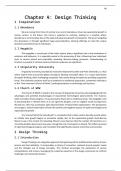48
Chapter 4: Design Thinking
1 Inspiration
1.1 Abundance
We are moving from times of scarcity to an era of abundance, driven by exponential growth in
various sectors. In the future, this trend is expected to continue, leading to a situation where
abundance is commonplace due to the rapid and expansive growth of companies. The key to navigating
this abundance is through significant hyper-personalization, tailoring offerings to meet the unique
demands and preferences of individuals.
1.2 Amygdala
The amygdala, a crucial part of the limbic system, plays a significant role in the modulation of
emotions and behaviors. It is especially pivotal in the processing of fear, influencing how individuals
react to various stimuli and potentially impacting decision-making processes. Understanding its
function is essential in contexts where emotional responses are significant.
1.3 Singularity University
Singularity University, founded by visionaries Raymond Kurzweil and Peter Diamandis, is a hub
where experts from around the globe converge to develop innovative ideas. It is a space that fosters
disruptive thinking, often challenging companies' fears about being disruptive by providing supportive
funds. The institution positions itself as an antithesis to traditional approaches, sometimes referred to
as the "Anti-movement Church of Wow," pushing boundaries in technology and business.
1.4 Church of WOW
The Church of WOW is linked to the concept of Singularity University, acknowledging both the
advantages and potential disadvantages of exponential technological advancements. For instance,
while innovation drives progress, it may also lead to fewer jobs in traditional areas. The amygdala's role
in processing fear is relevant here, as it can signal the dangers, such as negative social consequences
like job loss, that may accompany rapid advancements of exponential organizations. This perspective
encourages a critical examination of both the positive and negative impacts of rapid technological and
organizational growth.
The "second half of the chessboard" is a metaphor that is often used to describe a point where
an initially slow growth begins to accelerate rapidly, akin to the exponential growth described by
Moore's Law in the context of computing. Moore's Law observes that the number of transistors on a
microchip doubles about every two years, though the cost of computers is halved. This reflects a period
of rapid technological progress and innovation that significantly impacts economies and societies.
2 Design Thinking
2.1 Introduction
Design Thinking is an integrative approach that goes beyond the traditional boundaries of mere
process and tool utilization. It encapsulates a culture of innovation, centered around people's needs
and the strategic use of design principles. This mindset encourages the exploration of various
interpretations and choices, leveraging the collective expertise of the design community to confront
challenges and materialize dreams.
, 49
This approach is fundamentally human-centered, employing the designer's toolkit to weave
together the needs of individuals with the possibilities that technology offers, ensuring that the
strategies devised are not only innovative but also viable and essential for business success. The value
of Design Thinking lies in its application—much like art, the outcome is as distinct as the artist, whether
it be an untrained novice or a master like Picasso, the quality and impact of the work vary substantially.
2.2 The Dimensions
Design Thinking's multi-layered framework begins with the two-dimensional tools of
conceptual mapping, customer journey examination, persona development, and stakeholder mapping,
which are foundational for user-centric design. Expanding into the third dimension, we delve into the
Design Thinking process, as practiced by innovators like IDEO, which emphasizes iterative cycles of
ideation, prototyping, and testing. The fourth dimension extends into service design, which takes a
systemic view, orchestrating touchpoints to ensure seamless and impactful user experiences. Each
dimension builds upon the other, facilitating a deeper understanding and application of design in
business and innovation.
10 DIFFERENCES
Traditional Strategic Planning Agile Strategic Design
Exploitation: Small Scope Exploration: Designing the
improvements on the status future, something not existing
quo, starting from the known yet
Top Down: One to many, Direction Bottom-Up: Many to many, co-
management level exercise creative company-wide
exercise
Analysis: Rigorous analysis, Thinking Intuition : Empathic
quantitative focus understanding, qualitative
focus
Uniform & Structured : One Type Adaptable & Agile: Flexible
size fits all, clear steps to take approach, steps adapted along
the way
Linear: Waterfall process, steps Process Iterative: Iterative process,
are taken one after the other steps can occur simultaneously
and be repeated
Presentations: Convincing Decision Making Prototyping: Showing tangible
people through PowerPoint solutions and generating
presentations and excel-files feedback
One best solution: Search for Judgement Many possible solutions:
reliability and certainty in one search for new and better
best solution that might work solutions that work
Passive: Long, sitting meetings Energy Active: standing, walking
with endless discussions around, creative meetings
focused on building solutions
Verbal: PowerPoint, word & Communication Visual: Visual, verbal and
excel templates after the kinesthetic harvesting during
meeting the meeting
After: Learning after the full Learning During: Learning continuously
cycle has ended as from the start




